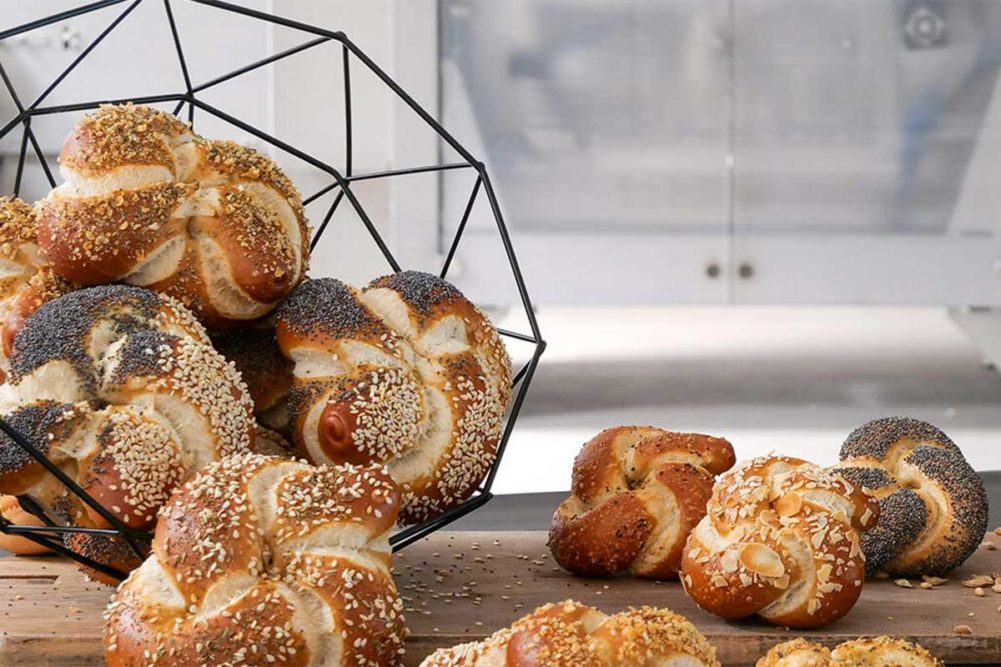Pretzel manufacturers can get creative with new formats and shapes. Changing up the shape or format of a pretzel can even have the added benefit of easing the seasoning process. Seasoned pretzels have driven the category’s growth in recent years, yet seasoning pretzels remains a challenging process.
“Braided pretzels are rising in popularity because the seams of a braided pretzel are able to better keep seasoning on the pieces,” explained Nico Roesler, North American pretzel and snack equipment sales manager, Reading Bakery Systems (RBS). “More seasoning, more flavor equals more opportunity to reach new consumers with a wider range of flavors.”
Braiding a pretzel, or even twisting and cutting the pretzel, exposes that open structure on the inside of the pretzel, Lipika Mandal, food technologist, Spooner Vicars, a Middleby Bakery company, pointed out. The shiny outer shell characteristic of the pretzel is difficult to season, but the inside is much easier.
“If you want to season the product perfectly then you need to create a way to get into the open structure inside the product,” she explained. “You can do that by creating a twist, cut or braid so the interior lighter structure gets exposed for the seasoning to adhere to.”
While new shapes, structures and formats may grab consumers’ attention and make seasoning easier, each comes with their own unique challenges, Mr. Roesler pointed out. When it comes to hard pretzels, delicate shapes can be more likely to break during baking or in the packaging. Flat pretzels, a trending shape that creates a cracker-like pretzel, can be tricky to maintain consistency throughout the process.
“First, flat pretzel dough needs to be consistent in its moisture and age so it can be extruded properly,” Mr. Roesler explained. “The best way to manage this is through a continuous mix process to eliminate variability. All dough is mixed and processed in the same amount of time over many shifts.”
Once mixed, these pretzel shapes require accurate cutting so they are all the same weight regardless of where they sit across the belt. When it comes to applying the lye or caustic solution, Mr. Roesler noted that flat pretzels can face the same challenges as pretzel bites: floating throughout the caustic bath rather than being fully submerged.
“When applying the caustic solution that gives the pretzel its color, texture and taste, producers need to use a waterfall applicator to stick the pieces to the belt prior to the bath in the pretzel cooker,” he said.
Even after the cooker, these flat pieces risk sticking to the oven belt during baking. Pre-heat burners can warm the belt so flat pieces sear on the bottom once transferred.
“It’s similar to searing a steak,” Mr. Roesler explained. “Create that sear and the steak will release from the pan without any issue. The pretzel pieces, with this extra hot belt, then bake and release from the belt easily at the end of the oven.”
Unique shapes aren’t limited to just hard pretzels though. Soft pretzels can also be formed in a variety of shapes and sizes, and when it comes to scoring, things can get tricky when the shapes get creative. Production efficiency counts on a predictable, repeatable size and shape. Vision systems can help bakers maintain their efficiencies while still delivering the interesting shapes customers and consumers are looking for.
“During scoring, for example, the system helps the robot reorient the scoring to align with product position, prevents downtime related to manual adjustments to the positioning of the products and minimizes the product losses due to mispositioned scores,” said Felix Pang, sales engineer, ABI.
While pretzel companies may be expanding the definition of what a pretzel can be, they’ll need the equipment and operational strategies necessary to support this growing category. With minimal changeovers and a few tools at the ready, pretzel manufacturers can incorporate new products without skipping a beat in production.
Pretzel buns help restaurants differentiate their burgers and sandwiches and provide consumers a way to elevate their eating at home. This has become more important as consumers continue to reserve their food spending for at-home eating while bringing that restaurant quality to their dining room tables.
“The flavor that comes from that lye bath continues to gain traction with consumers,” said Matt Zielsdorf, director of sales for Fritsch, a Multivac Group company. “It’s a premium, and when you go into a restaurant, when you have a premium burger, it often comes on a pretzel bun.”
Fritsch’s Multitwist can create a tightly twisted pretzel into the form of a roll at up to 2,000 pieces per hour. The product only requires a twisting tool that can be quickly and easily changed out on the Multitwist without additional tools.
Scoring pretzel buns is where things can get tricky on the production line as any bun will need to remain stationary during scoring to ensure a clean cut. ABI’s ultrasonic systems provide precision scoring.
“The use of plunge scoring instead of a drag blade will reduce the chances that the product moves during the cutting operation and produces a clean cut,” Mr. Pang said. “The ultrasonic blades also minimize instances of blades sticking to product as they withdraw.”
This article is an excerpt from the October 2023 issue of Baking & Snack. To read the entire feature on Pretzel Processing, click here.





